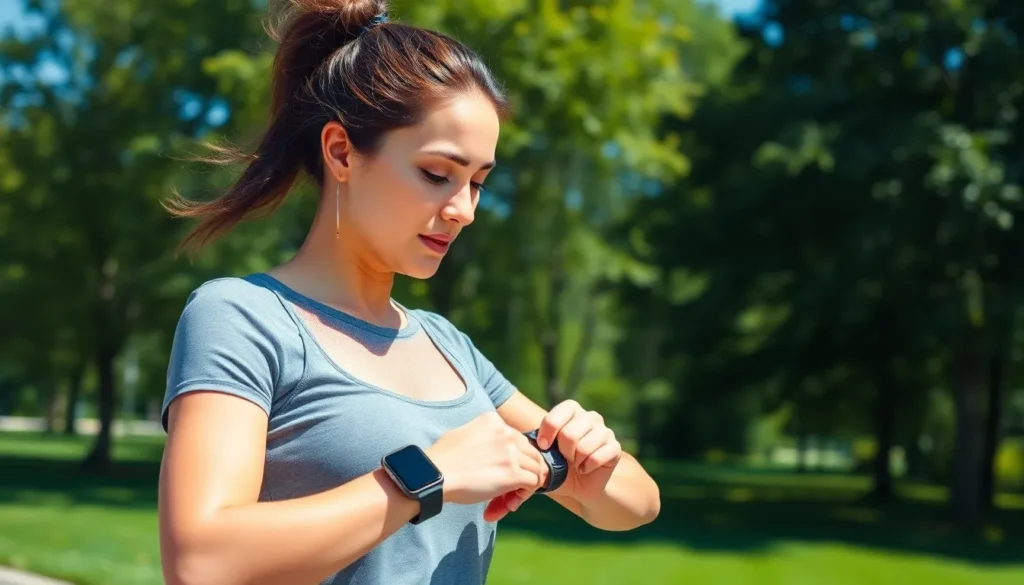In a world where technology seems to have a mind of its own, wearable tech has emerged as the stylish sidekick everyone wants. Forget about clunky gadgets; these sleek devices are transforming how people track health, stay connected, and even make fashion statements. Who knew that a simple wristband could turn someone into a fitness guru or a sleep expert overnight?
But it’s not just about looking cool while counting steps. Wearable technology offers real benefits that can enhance daily life. From monitoring heart rates to reminding users to stand up and stretch, these gadgets are like personal assistants that fit right on your wrist. As they become more integrated into everyday routines, the question isn’t whether to embrace them, but rather how quickly one can strap one on and join the revolution.
Benefits Of Wearable Technology
Wearable technology encompasses devices like smartwatches, fitness trackers, and eyewear that users wear on their bodies. The evolution of these gadgets reflects technological advancements, moving from bulky prototypes to sleek designs. Users now find these devices blend seamlessly into their everyday lives, providing functionality without sacrificing style.
Health tracking serves as a primary function of many wearables. Devices monitor heart rates, steps taken, and sleep patterns, enabling users to gain insights into their well-being. Fitness experts often recommend using such metrics to motivate physical activity and enhance overall health.
Additionally, wearables offer convenience through notifications and reminders. Users receive alerts for messages, calls, and calendar events directly on their devices, minimizing disruptions. This hands-free functionality allows individuals to remain connected while engaging in physical activities.
These technologies also provide valuable data for professionals in various sectors. Healthcare providers utilize data collected by wearables to monitor patients’ conditions remotely. In this context, the integration of wearable tech streamlines patient care, enhancing communication between doctors and individuals.
Moreover, augmented reality wearables introduce new interactive experiences. Users can enhance their environment with digital overlays, creating immersive educational and entertainment opportunities. This capability demonstrates the expanding potential of wearable tech beyond health and fitness.
Overall, wearable technology represents a pivotal shift in how individuals approach their daily routines. With a focus on efficiency, functionality, and design, these devices continue to reshape personal and professional landscapes.
Improved Health and Fitness Tracking

Wearable technology significantly enhances health and fitness tracking. Users gain insights into personal health metrics effortlessly.
Heart Rate Monitoring
Heart rate monitoring features enable users to track their heart rates continuously. This metric helps identify exercise intensity and overall cardiovascular health. Wearable devices often include alerts for abnormal heart rates, providing timely information. Fitness enthusiasts appreciate real-time feedback. Research shows that regular heart rate monitoring contributes to better workout performance and safety during physical activities. Individuals can set specific heart rate zones to maximize workout effectiveness. Integration with smartphone apps allows users to analyze trends and adjust training regimens based on data collected.
Sleep Quality Improvement
Sleep tracking capabilities within wearable technology aid users in understanding their sleep patterns. Devices monitor duration and quality of sleep, offering critical insights. Users can identify factors that affect their rest, like interruptions or restless periods. Many wearables use advanced sensors to provide detailed data on sleep stages, like REM and deep sleep. Making adjustments based on this data leads to improved sleep hygiene and overall well-being. Research indicates that individuals who track their sleep often achieve healthier sleep habits. Notifications and reminders also encourage users to maintain a consistent bedtime, enhancing nighttime routines.
Enhanced Connectivity and Communication
Wearable technology enhances connectivity and communication, providing users with real-time information and seamless interactions.
Smart Notifications
Smart notifications keep users updated without interrupting their daily activities. Devices buzz or light up to alert users of calls, messages and updates. Users can filter notifications to prioritize important communications, reducing distractions from less urgent messages. Wearable technology allows quick access to essential information, helping individuals stay organized and focused throughout the day. Studies show that users experience enhanced productivity due to fewer interruptions while maintaining connectivity.
Hands-Free Operations
Hands-free operations transform the way users interact with their devices. Voice commands enable individuals to control functions without needing to reach for their smartphones. These features allow for safe communication during activities like driving or exercising. Users engage with wearables using simple vocal cues to send messages or make calls, promoting interaction without disruption. The convenience of hands-free mechanics supports multitasking, making it easier to manage daily responsibilities while remaining connected. Research indicates that hands-free technology increases user satisfaction and engagement with wearable devices.
Data Collection and Personalization
Wearable technology excels in data collection, allowing users to gain invaluable insights into their health and lifestyle. By continuously monitoring various metrics, these devices create a comprehensive profile of user behavior.
User Behavior Insights
Wearables track physical activity, sleep patterns, and heart rates, providing a detailed overview of individual habits. This information helps users understand their daily routines and identify areas for improvement. Insights from activity tracking reveal trends, enabling users to see how their behaviors correlate with health outcomes. For instance, consistent step tracking can motivate an individual to increase physical activity, while sleep analysis shows how various factors affect rest quality. Analyzing this data empowers users to make informed decisions for better health management.
Tailored Recommendations
Personalized recommendations stem from the insights gathered by wearables. By analyzing users’ data, these devices suggest customized fitness goals and health strategies. For example, if a user frequently registers low sleep quality, the device might recommend adjustments in bedtime or relaxation techniques to enhance sleep hygiene. Similarly, fitness trackers often propose increased activity levels based on past performance. Each recommendation aims to support healthier habits and improve overall well-being, ensuring that users receive guidance tailored to their specific needs.
Increased Productivity and Efficiency
Wearable technology significantly boosts productivity and efficiency for users across various settings.
Task Management
Wearable devices streamline task management by providing reminders and notifications. Individuals receive alerts for appointments, deadlines, and important tasks, allowing for seamless scheduling. Smartwatches and fitness trackers can integrate with calendars, ensuring important events stay top of mind. Users quickly check off completed tasks with a simple tap, reducing the need for manual tracking. Moreover, physiological feedback, such as stress levels, helps users prioritize tasks effectively. By having this data at their fingertips, individuals can allocate time better and focus on critical projects.
Time Management
Wearable technology fosters better time management through real-time data insights. Users track their schedules and activities throughout the day, identifying where time is spent most effectively. Integration with productivity apps allows for the measurement of work segments and breaks, promoting focused work periods. Notifications serve as gentle reminders to stay on task, enhancing concentration during work hours. Additionally, fitness goals encourage individuals to incorporate movement into their routines, optimizing energy levels over the course of the day. Users reap the benefits of improved time usage, leading to more productive environments overall.
Conclusion
Wearable technology is reshaping how individuals approach health and productivity. With the ability to track vital metrics and provide real-time feedback, these devices empower users to make informed lifestyle choices. The integration of smart notifications and hands-free operations enhances convenience and connectivity, allowing for seamless multitasking.
As wearables continue to evolve, their potential to improve daily routines and health management becomes increasingly evident. By harnessing the power of data, users can personalize their fitness and wellness strategies. Embracing wearable technology isn’t just about staying current; it’s about enhancing overall well-being and achieving a more balanced life.


